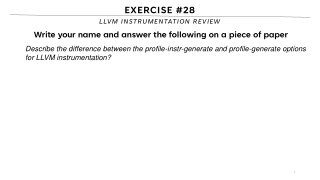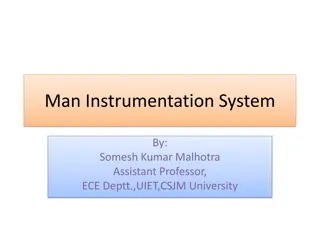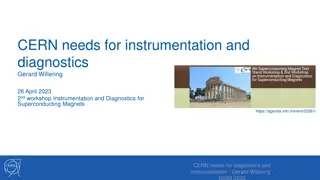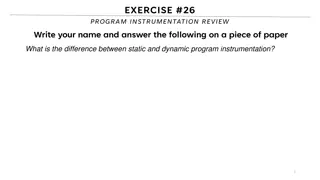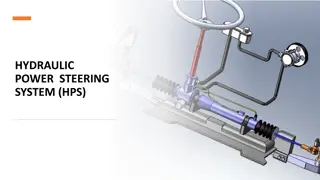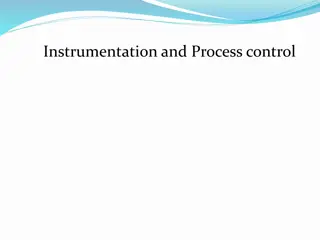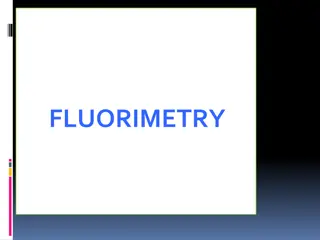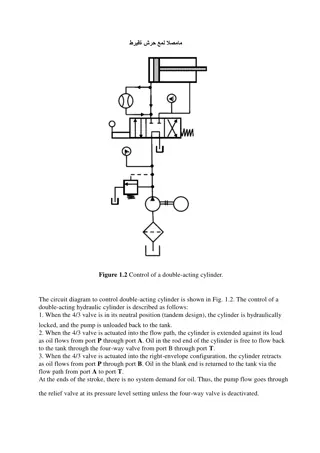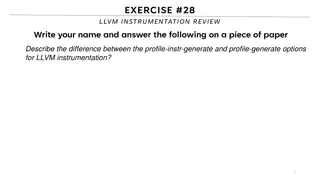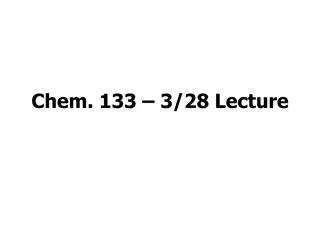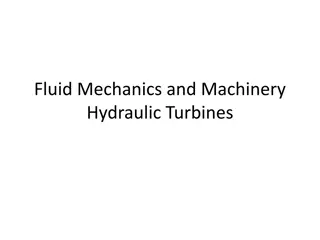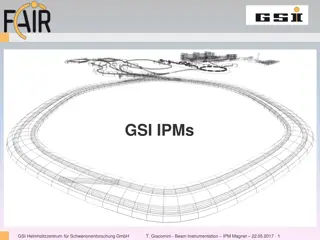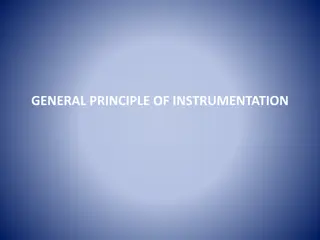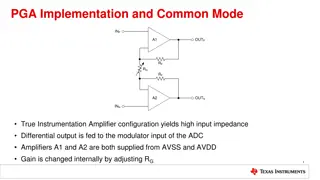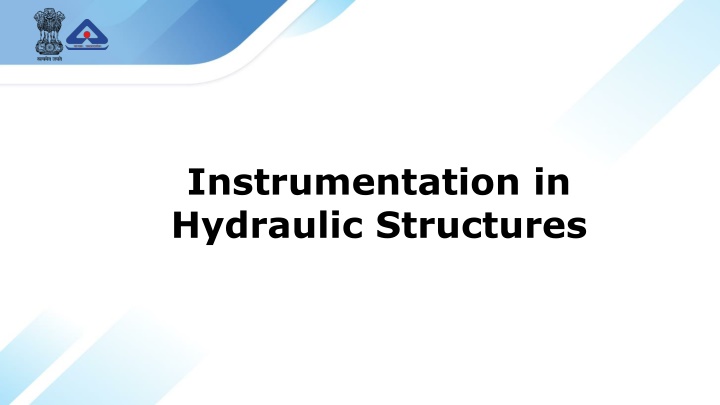
Critical Importance of Dam Instrumentation in Hydraulic Structures
"Learn about the crucial role of instrumentation in monitoring and assessing dam structures for safety, performance, and stability. Explore the need, objectives, and benefits of dam instrumentation in ensuring structural integrity and preventing failures."
Download Presentation

Please find below an Image/Link to download the presentation.
The content on the website is provided AS IS for your information and personal use only. It may not be sold, licensed, or shared on other websites without obtaining consent from the author. If you encounter any issues during the download, it is possible that the publisher has removed the file from their server.
You are allowed to download the files provided on this website for personal or commercial use, subject to the condition that they are used lawfully. All files are the property of their respective owners.
The content on the website is provided AS IS for your information and personal use only. It may not be sold, licensed, or shared on other websites without obtaining consent from the author.
E N D
Presentation Transcript
Instrumentation in Hydraulic Structures
Table of content 1DAM INSTRUMNETAION DAM INSTRUMNETAION NEED OF DAM INSTRUMENTATION INSTRUMENTATION OBJECTIVES 2Monitoring PARAMETERS TO BE MONITORED SELECTION OF INSTRUMENTS 3PURPOSE OF DAM INSTRUMENTAION PURPOSE OF DAM INSTRUMENTAION PHASE OF DAM INSTRUMENTAION LEVEL OF DAM INSTRUMENTAION 4TRIGGER VALUES TRIGGER VALUES ELEMENETS OF MONITORING SECHME PLANNING MONITORING SECHME WORK FLOW CHART 5DAMS INSTRUMENTATION EARTH ROCK FILL DAM CONCRETE DAM GEOPHYSICAL METHODS 6 CODE OF EARTHFILL & ROCKFILL DAM CODE OF GRAVITY DAM CODE OF CONCRETE DAM BIS CODES USED IN DAM INSTRUMENTATION
DAM INTRUMENTAION Instrumentation is the use of special devices to obtain critical scientific measurements of engineered behavior. Instrumentation consists of the various electrical and mechanical devices used to measure pressure, water flow, movement, stress, strain, temperature etc at a dam and its appurtenant structures. Symptoms of dam distress can be detected by a monitoring scheme designed with the right instrumentation. Instruments may operate mechanically, optically, electrically, or via pneumatic or hydraulic principles. Some instruments are read remotely; others are read at or near their sensors. The signal may be transmitted by a rod, wire,a liquid column, an electrical/optical cable, light or laser beam, a line-of-sight, or a radio signal.
NEED OF DAM INTRUMENTAION Every structure creates certain risks, and dams are no exception. Most dam failures that have occurred could have been avoided if the structure's behavior had been inspected, monitored, and analyzed continuously. Structural displacements, deformations, settlements, seepages, the piezometric pressure within the structure and its foundation are items that are the focus of a monitoring system. Effective instrumentation can play a vital role in the ongoing assessment of a dam's performance, can provide valuable information concerning the safety of the dam, and can help to improve dam design in the future.
Instrumentation objectives The primary purpose of any structures including dams and appurtenant structures is to develop safe, cost-effective, and reliable structures. Instrumentation plays a vital role in assessment and monitoring the changes in any parameter, some of which are listed below: Site Characterisation: Parameters of interest are identified depending on the type and function of a structure Design verification: To validate the assumptions with actual response of structure and assumed behaviour to be in close agreement Construction Control: Mid Way correction based on instrumented data Quality Control: to enforce the quality of workmanship on a project and to document that work was done to the specifications Safety: To issue safety warnings Legal protection: Used as evidence Performance: Long-term durability and stability
PARAMETERS TO BE MONITORED The important parameters to be regular monitoring in Concrete and masonry dams are listed below: i. Water Level and Pressures Reservoir Levels Uplift Pressures ii. Seepage and Leakage Seepage through Foundation/Abutment Leakage through holes and cracks in Dam Body iii. Movement Surface Vertical Internal - joints and cracks iv. Stress and Strains Stress/strains in concrete structure v. Temperature (Measured during construction) Evaluate mix design Placement rates Block/lift sizes Time of grouting of block joints Evaluate thermal loads/stresses vi. Seismic Loads Dynamic Studies/Analysis
SELECTION OF INSTRUMENTS While selection of instruments for monitoring for a particular project, the following basic requirements should be considered: i. Range: Range is the maximum distance over which the measurement can be performed, with greater range usually being obtained at the expense of resolution. ii. Resolution: The resolution is the smallest numerical change an instrument can measure. iii. Accuracy: The degree of correctness with respect to the true value is the accuracy, and it is usually expressed as a plus-or-minus number or as a percentage. iv. Precision: Precision is the repeatability of similar measurements with respect to a mean, usually reflected in the number of significant figures quoted for a value. v. Conformance: Conformance is whether the presence of the instrument affects the value being measured. vi. Robustness: This is the ability of an instrument to function properly under harsh conditions to ensure that data accuracy and continuity are maintained. vii. Reliability: Reliability is synonymous with confidence in the data; poor quality or inaccurate data can be misleading and is worse than no data.
PURPOSE OF DAM INSTRUMENTAION The primary purpose of instrumentation is to supply data to aid in evaluating the safety of a structure by collecting quantitative data on its performance and by detecting problems at an early and preventable stage A secondary purpose is to enable comparison of actual behavior with predicted behavior,which verifies design adequacy and helps gather useful information for refining the design of similar structures in the future.
PHASES OF INSTRUMENTAION DESIGN PHASE Instrumentation part of investigations to establish baseline conditions like groundwater profile and for geo-technical monitoring May be used during construction and further phases to know changes in baseline conditions CONSTRUCTION PHASE Confirmation of design assumptions Changes in groundwater s stability conditions Safety and Quality control FIRST RESERVOIR FILLING PHASE Providing an early indication of unusual performance Providing confirmation of satisfactory performance Providing data to understand actual performance Monitoring the performance to gauge the dam safety Measuring the impact of various loading conditions. OPERATION PHASE
LEVEL OF INSTRUMENTAION Level of instrumentation and frequency of monitoring depends on Hazard potential of dam Age or condition of dam Variation in loading conditions History of abnormal behaviour Seismic risk at the dam site Level of instrumentation and frequency of monitoring may change based on the abnormal performance
MAINTAINANCE & PERFORMANCE OF INSTRUMENTAION For instrumentation data to be of any value, the instruments must be calibrated and maintained properly. Proper care of the equipment is essential to ensure correct readings. Inaccurate readings are worse than no readings at all because they can mislead one about the performance of a dam and can allow serious problems to develop undetected. Check onsite instrumentation on aregular basis for damage fromweather, traffic, or vandalism. Follow all manufacturer sinstructions and guidelines as givenin the operating manuals, including instructions for proper care of the equipment.
TRIGGER VALUES TRIGGER VALUES Tigger values for each parameter being monitored are needed to be defined in the Instrumentation Plan. This will enable the responsibilities and the action plans for any emergent situation. The trigger levels may be classified as: Baseline Level: The observed values fall within expected limits in line with that predicted during design; Warning Level: Monitored values exceed the baseline level; Alarm level: The observed values exceed the warning level The Baseline, Warning and Alarm levels shall be defined by the Designer. The trigger levels shall be assigned for each parameter based on the design values and material characteristics. These are dependent on the type of structure and the geology. For example; the baseline values for anchor loads may be considered to be satisfied when the measured change in anchor load is within 50% of the yield strength of anchor. Similarly, warning level may be supposed to have reached when measured anchor load exceeds 50% of yield strength of anchor and alarm level may be fixed when anchor load exceeds 62.5% of the yield strength. Similarly trigger levels can be defined for other parameters like pore pressures, uplift pressures, vertical settlements, horizontal movements, temperature changes, stress/strains, convergences, dam deflections etc.
KeyElementsofMonitoringScheme 01 02 03 04 Monitoringand WarningService Develop Hazard Monitoring and Early Warning Service Are theright parameters being Monitored? Is there a sound scientific basis for making forecast? Can accurate and timely warnings be generated? Dissemination and Communication Communicate Risk information and Early Warnings Do Warnings reach allof those atrisk? Aretherisks and warnings understood? Is warning information clear and usable? Response Capability Build Community Reponses Capabilities Are response plans up todate and tested? Are local capacities and knowledge made use of? Arepeopleprepared and ready toreacttowarnings? Risk knowledge Systematically collect data and undertake Risk assessments Are theHazards and Vulnerabilities wellknown? What arethepatterns and trends? Are risk maps and data available? Deterministic or Probabilistic Analysis?
PlanningaMonitoringScheme 01 02 04 03 DESIGN- Risk knowledge Understand Project Risk Scenarios Design Criteria Choice ofGeo- indicators Calculate trigger values Define locations C provide redundancies EDUCATION- Response Capability Risk Perception Safe Behaviors Response to Warnings Population Involvement Dissemination s Communication MONITORING Instruments Installation Data Collection Data Transmission Data Elaboration Data Interpretation Comparison with threshold Forecasting Methods Warning
Carrying out routine monitoring of all instrument as planned Compile check and analysis data Any exceedance of alert level No Response Actions Workflow Chart Yes Yes Any exceedance of action level Immediately inform Client, Designer and PMC Any exceedance of alarm level No No PMC notify to Client Notify PMC and Client Implement emergency actions Notify PMC and Client Submit interim report to designer and PMC approved report will be sent to Client Implement the approved response action and submit report Suspend construction works in affected area Inspect affected area and physically monitor the situation Submit report on construction methods full history of movement response actions taken or any other appropriate actions are required Client approved report, contractor resume work, I&M team include exceedance in monthly I&M team report to PMC and Designer Present daily/weekly/monthly report as necessary Incident inspection & emergency review meeting
EARTH ROCK FILL DAM 1. PoreWaterPressure 2. Seepage/drainage a. b. Surfacemovements ReservoirandT ailwaterlevel Seismic Stressandstrains Rainfall WaveHeightandevaporation Deformation Internalmovement 3. 4. 5. 6. 7. 8.
EARTH ROCK FILL DAM s Piezometer TotalPressure Cell Settlement Gage Extensometer/ Inclinometer SurveyRef.Point Measurement Weir WaterLevel P G e C P P P P G e G G e G e s G C C P PeP P P P P G eP e G e G e G e C G C e s e P P P P P P P P w s P P P P P C C w P P P
Earths Rockfilldams Waterlevels measureme measureme Parameter Temperatur Movement measurem and pore Seismic pressure and flow Visual Crack / observati joint Uplift Seepa e nt Quali flow Wat e nt nt ge er ty s Location on s U/S slope D/S slope Abutments Crest Internal drainage system Relief Drain Riprap and other slope protection
Concretedams measuremen measuremen measuremen Temperature Crack / joint Stress-strain Parameter measureme Movement levels and and pore Seismic pressure Visual observati Uplift Wate Seepa Quali flow n t t t ge t Water flow ty s r Location on s U/Sslope D/Sslope Abutments Crest Internal drainagesystem Relief Drain Galleries Sluiceways/ controls
GeophysicalMethods for Dam Investigation Geophysical Methods Issues andConcerns Earth Embankment Dams Water leaks landslide Concrete Dam Cracks Masonry Dams Water leaks Degradati on Sink holes Strength Electrical Resistivity Y Y Y Streaming Potential Y Y Y Georadar Radar Tomography Y Y Y Y Y Y Y Y Y Y Y Seismic Tomography Y Y Y Y Y Seismic Refraction Y Y Y
Suggested Frequencyof Readings forSpecified Instruments TypeofInstrument DuringConstruction Construction Duringinitial filling DuringPeriod ofOperation Year 2to3 Shutdown Year 1 Regular Vibrating wire piezometers Hydrostatic uplift pressure pipes W M W BiW M M W M W W BiW M Porous-tube piezometers Slotted-pipe piezometers Observation wells M M W W M M M M W W M M W M W W BiW M Seepage measurement (weirs and flumes) W M W W M M
ListofISCodesRelatedtoEarth androckfill DamInstrumentation Indian Standar d IS: 7356-1 Year of Publication Title 2002 Code of practice for installation, maintenance and observation of instruments for pore pressure measurements in earth dams and rock fill dams, Part 1: Porous tube piezometers Installation, observation and maintenance of instruments for pore pressure measurements in earth and rock fill dams - code of practice, Part 2: Twin tube hydraulic piezometers Guide for types of measurements for structures in river valley projects and criteria for choice and location of measuring instruments, Part 1: For earth and rock fill dams Code of practice for installation and observation of cross arms for measurement of internal vertical movement in earth dams Code of practice for installation and observation of base plates for measurement of foundation settlement in embankments Criteria for design of small embankment dams IS: 7356-2 2003 IS: 7436-1 1993 IS: 7500 2000 IS: 8226 2017 IS: 12169 1987
List of IS Codes Related to Earth and rock fill Dam Instrumentation Indian Standa rd IS: 12949 Year of Publication Title 2013 Code of practice for installation, maintenance and observation of instruments for pore pressure measurements in earth dams and rockfill dams: Electrical pore pressure cells - vibratory wire type Code of practice for installation and observation of instruments for temperature measurements inside dams; resistance type thermometers Guide for types of measurements for structures in river valley projects and criteria for choice and location of measuring instruments, Part 2: Concrete and masonry dams Code of practice for installation, maintenance and observations of pore pressure measuring devices in concrete and masonry dams, Part 1: Electrical resistance type cell Installation, maintenance, and observations of pore pressure measuring devices in concrete and masonry dams - code of practice, Part 2: Vibrating wire type cell Code of practice for selection, splicing, installation and providing protection to the open ends of cables used for connecting resistance type measuring devices in concrete and masonry dams IS: 6524 1972 IS: 7436-2 2019 IS: 8282-1 1976 IS: 8282-2 1996 IS: 10334 1982
List of IS Codes Related to Earth and rock fill Dam Instrumentation Indian Standa rd IS: 10434-1 Year of Publication Title 2003 Installation, maintenance, and observation of deformation measuring devices in concrete and masonry dams - guidelines, Part 1: Resistance type joint meters IS: 10434-2 1996 Guidelines for installation, maintenance, and observation of deformation measuring devices in concrete and masonry dams, Part 2: Vibrating wire type joint meter IS: 13073-1 2002 Installation, maintenance, and observation of displacement measuring devices in concrete and masonry dams - code of practice, Part 1: Deflection measurement using plumb lines
ListofIS CodesRelatedtoConcrete and MasonryDamInstrumentation Indian Standard YearofPublication Title IS: 13073-2 2000 Code of practice for installation, maintenance and observation of displacement measuring devices for concrete and masonry dams, Part2:Geodeticobservation -crestcollimation IS: 13232 1992 Installation, maintenance, and observations of electrical strain measuring devices in concrete dams - Code of practice IS: 14278 1995 Stress measuring devices in concrete and masonry dams - Installation, commissioning and observations - Code of practice
ListofISCodesRelatedto DamInstrumentat inGeneral Indian Standa rd IS: 1191 Year of Publication Title 2016 Hydrometric determinations -- vocabulary and symbols IS: 4967 1968 Recommendations for seismic instrumentation for river valley projects IS: 6532 1972 Code of practice for design, installation, observation and maintenance of uplift pressure pipes for hydraulic structures on permeable foundations Guidelines for instrumentation of barrages, weirs IS: 14248 1995 IS: 14750 2014 Code of practice for installation, maintenance, and observation of seepage measuring devices for concrete/masonry and earth/rockfill dams 2013 Code of practice for installation, maintenance, and observation of the instruments for vibration studies other than earthquakes on Hydraulic Structures and Machines IS: 14793
ListofIS CodesRelatedtoMeteorological Instrumentation Indian Standa rd IS: 4849 Year of Publication Title 1992 Meteorology - Rain measures - Specification IS: 5225 1992 Meteorology - Rain gauge, non recording - Specification IS: 5235 1992 Meteorology - Rain gauge, recording - Specification IS: 5793 2024 Specification for Aneroid Barometers IS: 5798 1970 Specification for Mercury Barometers IS: 5799 1970 Specification for Wind vane
List of IS Codes Related to Meteorological Instrumentation Indian Standa rd IS: 5900 Year of Publication Title 1970 Specification for Hair Hygrograph IS: 5901 1970 Specification for Thermograph, Bimetallic IS: 5912 1997 Specification for Anemometer, Cup Counter IS: 5924 1988 Specification for Clock Mechanism and Drums for Meteorological Instruments IS: 5945 1970 Specification for Barograph, Aneroid IS: 5946 1992 Meteorology - Whirling psychrometer - Specification IS: 5947 1970 Charts for recording meteorological instruments IS: 5948 1970 Specification for Thermometer Screens
List of IS Codes Related to Meteorological Instrumentation Indian Standard Year of Publication Title IS: 5973 1998 Pan evaporimeter - Specification IS: 6805 1973 Specification for Assmann Psychrometer IS: 6806 1973 Specification for Snow gauge IS: 6871 1992 Wind Equipment - Distant Indicating - Specification IS: 7243 1974 Specification for Sunshine Recorder 1974 Specification for Thermometer for Mercury Barometer IS: 7244 IS: 8336 1977 Specification for Thermoelectric Pyranometer
List of IS Codes Related to Meteorological Instrumentation Indian Standa rd IS: 8693 Year of Publication Title 1978 Specification for Net Pyrradiometer IS: 8754 1992 Electrical Anemograph - Specification IS: 9085 1979 Specification for Correction Slide for Mercury Barometers IS: 11875 1986 Specification for Diffuse Pyranometer IS: 11876 1986 Specification for Airmeter
List of IS Codes Related to Meteorological Instrumentation Indian Standa rd IS: 12781 Year of Publication Title 1989 Marine Bucket for Sea Surface TemperatureMeasurement - Specification IS: 13436 1992 Sensitive Anemometer - Specification IS: 13448 1992 Meteorology - Thermoelectric pyrheliometer - Specification IS: 13459 1992 Angstrem pyrheliometer - Specification IS: 15216 2002 Balloons - Meteorological IS: 15243 2002 Velocity Scale Set for Meteorological Purposes IS: 15253 2002 Dew Gauge - Specification SP 61 1994 General guidelines for automatic weather stations
LESSONS LEARNT Some of the lessons learnt while dealing with instrumentation and monitoring of dams, slope stability problems, underground caverns/tunnels and other associated structures are listed below: No instrumentation better than bad instrumentation Data once lost is lost forever e.g. deformations in underground excavations Keep your eyes and ears open visual inspections are vital and serves as verification tool even in case of malfunctioning of instruments Small amount of true, accurate, reliable and realistic data far better than large amount of inaccurate and erroneous data Consistency in monitored data needs to be maintained Proper identification of instruments and measuring units
LESSONS LEARNT Some of the lessons learnt while dealing with instrumentation and monitoring of dams, slope stability problems, underground caverns/tunnels and other associated structures are listed below: Calibration of instruments (wherever possible) and read out units at regular intervals Frequency of monitoring to be maintained for true behaviour of instruments Correlate data with previous observations and construction activities, or any environmental of natural factors or disturbances influencing the data Proper formats to be adopted for data recording Analysis covering overall variation in parameters with respect to original or initial readings and rate of change of parameters with time Improper interpretation may lead to more confusions and complicacies Assigning responsibilities at various levels owner, contractor, analysing agencies
Write to Us wrd@bis.gov.in



